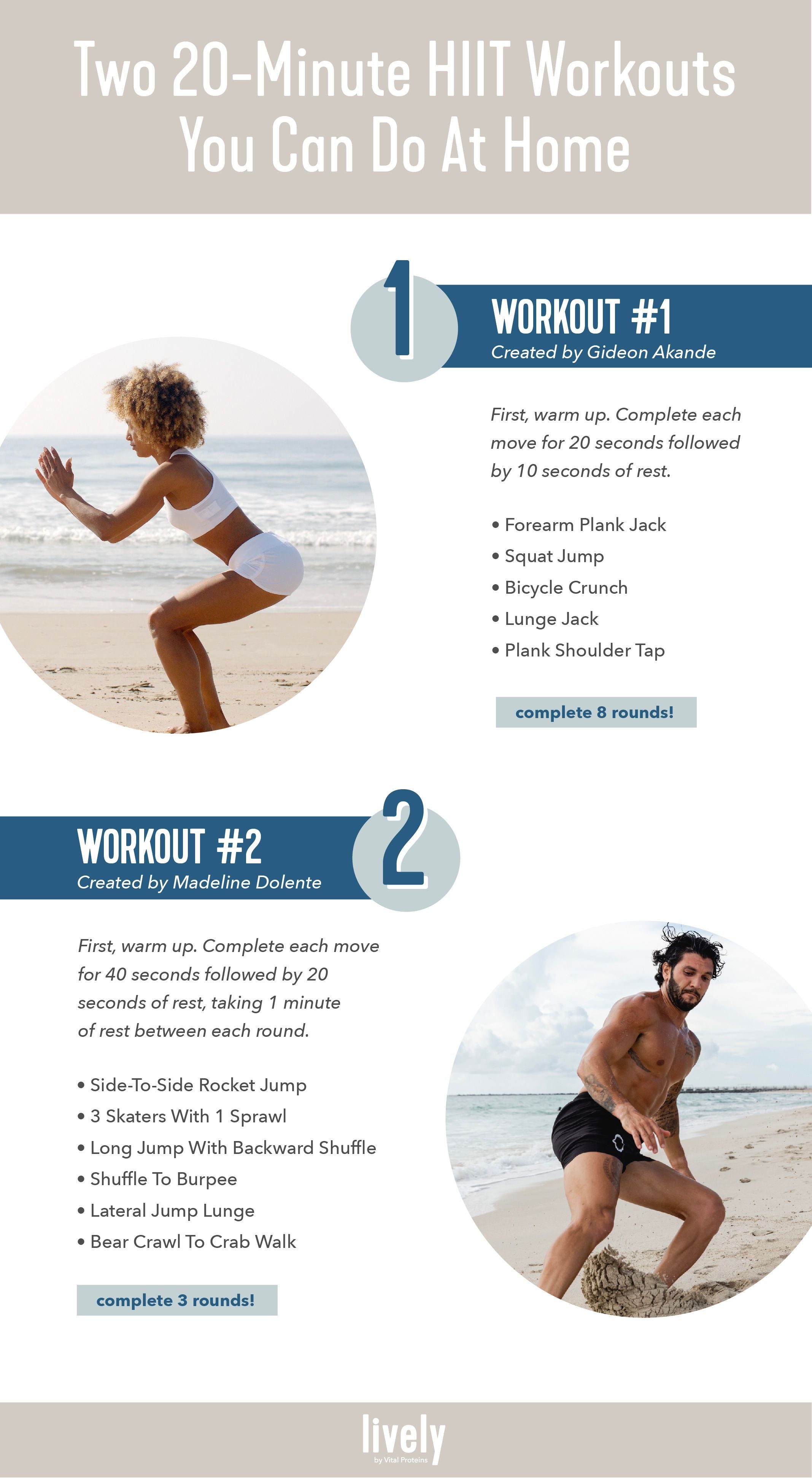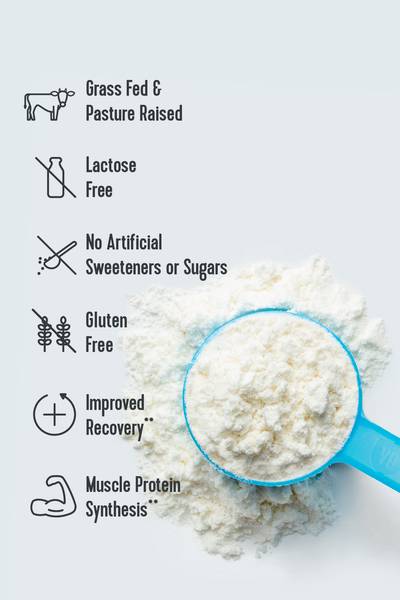Becoming a stronger, faster athlete requires hard work, but you might be intimidated by the thought of entering the weight room or maybe you're just starting your fitness journey. Good news: Getting in a good workout doesn't require fancy equipment, a lot of space or even a gym membership. Madeline Dolente, certified METAFIT HIIT coach, ACE personal trainer and creator of MadFitness, and Gideon Akande, trainer, coach and Founder of GetFitWIthGiddy, explain the benefits of HIIT workouts at home, and share two tough workouts you can try.
Ready, set, feel stronger.
Vital Note: This article has been made available for informational and educational purposes only. It is not intended to be a substitute for professional medical advice, diagnosis, or treatment. Always seek the advice of your physician or another qualified health provider with any questions you may have regarding a medical condition. Your licensed healthcare professional can best provide you with the diagnosis and treatment of any medical condition and assist you as well in deciding whether a dietary supplement will be a helpful addition to your regimen.

Is a HIIT workout at home effective with just body weight?
"Using your own body weight in a HIIT workout can be both an effective and an efficient use of time," says Dolente. "I've found using one's own body weight in a HIIT workout is the best way to start out and to teach your body to move better before adding resistance bands or weights."
Doing a HIIT workout at home with just body weight is a great solution for those who are short on time, have a small space for working out or are looking for an inexpensive way to start working out, Akande tells Lively.
How many times per week should you do HIIT training?
HIIT training is very different for everyone, says Akande. One thing that applies to all athletes, though, is that HIIT workouts shouldn’t be done every day. But if done safely two to three times a week, athletes can see great benefits to cardio, strength and athleticism by doing HIIT workouts at home.
Many people can benefit from doing HIIT workouts at home three to four days a week as part of a fitness program, as long as they do it every other day to give their body a chance to recover, Dolente tells Lively. But it should be taken on a case-by-case basis.
Related Articles
How long should HIIT sessions be?
Since a HIIT workout is high intensity (it's in the name), if your workouts are too long or you keep going once you are fatigued, you are at higher risk of injury, says Akande. Dolente loves 30-minute HIIT sessions. She says 30-minute HIIT workouts are often the sweet spot for herself and her clients.
"I think that is the proper amount of time with a 2 to 3-minute warmup and cool down," she says. "Anything longer would require more recovery within the workout."
Keep in mind, your entire workout doesn't need to be high-intensity, either. You can start out with steady state cardio and incorporate a few HIIT intervals as you start out your fitness journey, working your way up to a full HIIT session, explains Akande.
How Do You Do HIIT At Home?
Starting with a 20-minute HIIT workout is a great option, but you can tailor it to any length to fit your personal goals and fitness level. Remember, your entire workout doesn’t need to be high intensity — it should be tailored to your fitness level. You can choose a series of bodyweight moves that best fit what your training goals are.
Both Dolente and Akande created 20-minute HIIT workouts you can do at home. Before getting started, be sure to warm up for three to four minutes. Each workout can be modified and made easier for beginners with lower reps, shorter time or modified moves. When you are ready to advance, you can kick up the intensity at which you perform each move or add weights if you have them.
Akande's HIIT Workout
How to do it:First, warm up. Then, complete each move for 20 seconds followed by 10 seconds of rest. Repeat for 8 rounds.
Forearm Plank Jack
Start in a forearm plank position with forearms resting on the ground, flat back and feet together. Keeping core engaged, jump feet out wider than shoulder width. Then, jump feet in to return to starting position. Repeat.
Squat Jump
Stand with feet hip-width apart. Start by doing a regular squat and as you stand, engage your core and jump upward. Be sure to land softly, then repeat.
Bicycle Crunch
Lie face up with both hands behind head and legs bent at 45 degrees. Peel left shoulder off mat to bring left elbow toward right knee. At the same time, extend left leg straight. Then, bring right elbow to left knee as you extend right leg straight. Continue alternating in one fluid motion.
Lunge Jack
Start standing with feet hip-width apart. Jump up and land with left foot forward, bending both knees to drop into a basic lunge position. Make sure to land softly, with your forward knee aligned with forward foot and not any further to avoid injury. Press through right heel to jump back to and return to starting position. Then, repeat on right leg. Continue alternating. (To modify, skip the middle of the move and alternate jumping right and left leg forward, or perform walking lunges.)
Plank Shoulder Tap
Start in a high plank position. Keeping core engaged and back flat, lift right hand up to tap left shoulder. Return to starting position and lift left hand to tap right shoulder. Return to starting position and continue alternating.
Dolente's HIIT Workout
How to do it:First, warm up. Complete each move for 40 seconds followed by 20 seconds of rest, taking 1 minute of rest between reach round. Repeat for 3 rounds.
Side-To-Side Rocket Jump
Stand with feet shoulder width apart with arms by your side. Squat down, then jump up as high as you can, landing softly. Alternate jumping to the left and right.
3 Skaters With 1 Sprawl
Stand with feet wider than hips-width distance apart. Slightly bend your knees to lower into a squat, then bring your right foot diagonally behind your left leg and touch your toe down and pause. Then using your glutes, push off your left foot in a jumping movement to the right. Bring the left foot diagonally behind the right. Alternate to complete 3 skaters.
Then, to starting position and hinge at hips. Jump legs back into high plank position, pause, then jump legs back in toward hands. Repeat 3 skaters to 1 sprawl.
Long Jump With Backward Shuffle
Stand with your feet shoulder-width apart. Swing arms back behind your body as you bend your knees and push your hips back. Swing arms forward as you drive your feet into the ground, push hips forward, and explode forward off the ground, jumping as far forward as you can. Shuffle backward to return to starting position.
Shuffle To Burpee
Start standing with feet hip-width apart. Then, widen into an athletic stance, and lower into a squat. Shuffle the length of a yoga mat and back. Return to starting position. Then, hinge at the hips and bend knees to squat as deeply as you can and place your hands on the floor. Jump feet back to high plank position. With core engaged, bend elbows to lower chest to the floor, like a push-up. As you press back up, jump your feet back into a deep squat and jump (or stand) back up, landing on the balls of your feet. Repeat.
Lateral Jump Lunge
Stand with feet hip-width apart. Take a big step to the right, send hips back, and bend right knee to drop into a lateral lunge. Pushing off the ball of the left foot, lift right leg off the ground in one powerful motion, then return to side lunge position. Press back to the starting position. Repeat on the left side.
(To modify, take a big step to the right or left.)
Bear Crawl To Crab Walk
Start on all fours and lift your knees so they're at a 90-degree angle and hovering an inch off the ground. Move one hand and the opposite foot forward an equal distance while staying low to the ground. Switch sides, moving the opposite hand and foot. Repeat the movement while alternating sides, crawling about the length of a yoga mat. Then, flip over so you are faceup resting on your hands and feet with hips lifted off the ground. Walk backward on hands and feet to return to starting position. Repeat.
Who can benefit from HIIT workouts?
Anyone can benefit from HIIT workouts, no matter their age, fitness level or ability. And you can do HIIT workouts at home or the gym. Dolente has clients who have children that join the sessions, one client who is crushing HIIT workouts at 66, and a client who uses a leg brace. It's important to make sure that you modify any HIIT workouts to your specific injuries and properly warm up before any workout, says Dolente.
"HIIT shouldn't scare people away; the workouts are adaptable to whoever wants to do them," Akande says.
What are the benefits of HIIT workouts?
As we mentioned, HIIT workouts can be done anywhere, even at home. And you can see benefits even when using just body weight. Additionally, they can help you build muscle mass, strengthen your connective tissue, improve your coordination and cardio function. HIIT workouts (done at home or the gym) can help improve your overall athleticism, Akande says.
And one study has found that compared to a single 30-minute session of weight training, running or biking, HIIT burned 25 to 30 percent more calories. Dolente adds that due to the intensity of your workout, your metabolism will be elevated for up to 24 hours after your workout.
Plus, all moves are scalable. You can do so many variations of each move, your workouts won't get stale, says Akande, adding: "Over the course of your fitness journey you can scale HIIT workouts as needed and see great benefits."



















